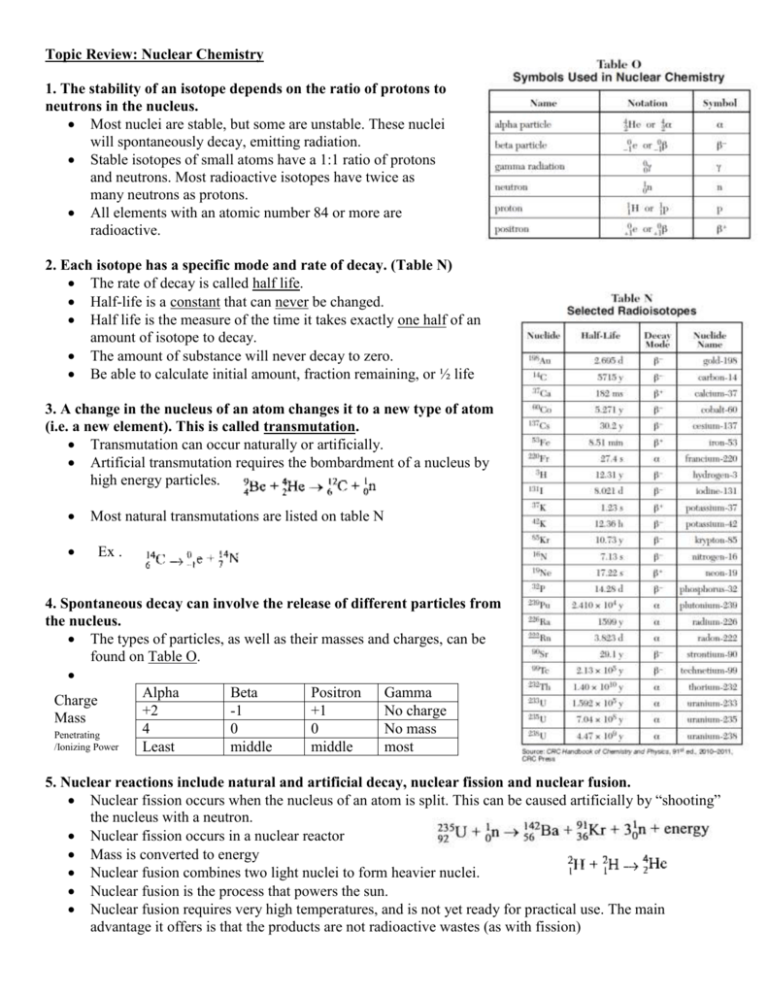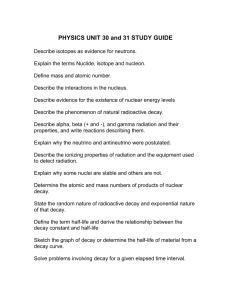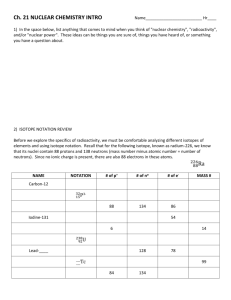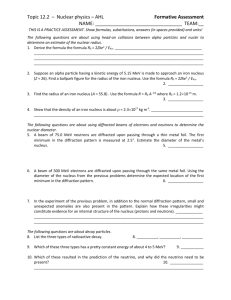File
advertisement

Topic Review: Nuclear Chemistry 1. The stability of an isotope depends on the ratio of protons to neutrons in the nucleus. Most nuclei are stable, but some are unstable. These nuclei will spontaneously decay, emitting radiation. Stable isotopes of small atoms have a 1:1 ratio of protons and neutrons. Most radioactive isotopes have twice as many neutrons as protons. All elements with an atomic number 84 or more are radioactive. 2. Each isotope has a specific mode and rate of decay. (Table N) The rate of decay is called half life. Half-life is a constant that can never be changed. Half life is the measure of the time it takes exactly one half of an amount of isotope to decay. The amount of substance will never decay to zero. Be able to calculate initial amount, fraction remaining, or ½ life 3. A change in the nucleus of an atom changes it to a new type of atom (i.e. a new element). This is called transmutation. Transmutation can occur naturally or artificially. Artificial transmutation requires the bombardment of a nucleus by high energy particles. Most natural transmutations are listed on table N Ex . 4. Spontaneous decay can involve the release of different particles from the nucleus. The types of particles, as well as their masses and charges, can be found on Table O. Alpha Beta Positron Gamma Charge +2 -1 +1 No charge Mass 4 0 0 No mass Penetrating /Ionizing Power Least middle middle most 5. Nuclear reactions include natural and artificial decay, nuclear fission and nuclear fusion. Nuclear fission occurs when the nucleus of an atom is split. This can be caused artificially by “shooting” the nucleus with a neutron. Nuclear fission occurs in a nuclear reactor Mass is converted to energy Nuclear fusion combines two light nuclei to form heavier nuclei. Nuclear fusion is the process that powers the sun. Nuclear fusion requires very high temperatures, and is not yet ready for practical use. The main advantage it offers is that the products are not radioactive wastes (as with fission) 6. Nuclear reactions can be represented by equations that include symbols which represent atomic nuclei (with mass number and atomic number), subatomic particles (with mass and charge) and emitted particles. Use table N to determine decay mode Remember the atomic mass and charge must add up on each side of the equation 7. Energy from fission and fusion comes from the very small fraction of mass that is lost – the reaction converts matter into energy. Einstein’s E=mc2 describes the relationship between energy and matter. 8. The energy released from nuclear reactions is much greater than that released from chemical reactions. 9. The risks associated with using radioactive isotopes include biological exposure (which may cause radiation poisoning, mutations, and cancer), long-term storage and disposal, and nuclear accidents. 10. Radioactive isotopes may be used in medicine (tracing chemical and biological processes), radioactive dating, industrial measurement, nuclear power, and detection and treatment of disease. I – 131 diagnose and treat thyroid C-14 C-12 ratio used for biological data (carbon dating due to long ½ life and presence in body) U-238 used for geologic dating (long ½ life and presence in rocks) decays to Pb-206 Co-60 used to treat cancer All isotope used on people must have a short ½ life and should be eliminated from the body quickly. Practice: 1) A sample of I-131 decays to 1.0 grams in 40 days. What was the mass of the original sample? 2) What is the total number of hours required for Potassium-42 to undergo three half-life periods? 3) In 6.20 hours, a 100 gram sample of Ag-112 decays to 25.0 grams. What is the half-life of Ag-112? Using your knowledge of nuclear chemistry, write the equations for the following processes: 1) The alpha decay of iridium-174 2) The beta decay of platinum-199 3) Positron emission from sulfur-31 4) Krypton-76 undergoes electron capture 5) Write the symbols for an alpha particle, beta particle, gamma ray, and positron. 6) If the half-life for the radioactive decay of zirconium-84 is 26 minutes and I start with a 175 gram sample, how much will be left over after 104 minutes? 7) Why is it difficult to make a fusion reaction occur?







